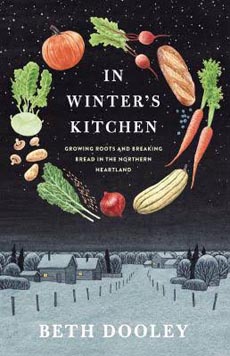 BOOK REVIEW:
BOOK REVIEW:
In Winter’s Kitchen, by Beth Dooley
Runestone, Volume 2
Reviewed by Allie Pikala
Having written several cookbooks, Beth Dooley is no stranger to the world of food. In Winter’s Kitchen is her first full-length narrative work, combining journalism with personal experience. While she does include several recipes at the end of the text, the majority of the book blends memoir with research illustrating the importance of locally and sustainably grown crops. Divided into chapters with titles such as “Potatoes” or “Cranberries,” these sections typically begin with an experience from the author’s own life, such as her cooking lessons with her grandmother. The chapters then widen in scope to examine the real people growing these foods in the Midwest.
As a Minnesotan myself, I found many opportunities to connect with Dooley’s writing. One of the earliest chapters, “Apples,” draws largely on the apple-breeding program at the University of Minnesota, which is the largest in the world. I was taught at a young age that Honeycrisp apples were created right in my community, and we were justified to be proud of this fact. Dooley’s interviews profile a wide range of folk, from a Hmong family who sells their vegetables at the St. Paul Farmers’ Market to the cafeteria staff in the Hopkins Public School district. This deep sense of place appeals to any Midwesterner, and also helps to characterize the area for those who have never been here.
Dooley succeeds at weaving the anecdotal with the historical, as exemplified in the “Wheat” chapter. She quotes the first Midwestern cookbook, published in 1877, to ground her passage on the role of flour in baking bread:
It took the baker a great deal of hand sifting to create the treasured white flour. The world’s best flour came from Hungary and was produced with a steel roller that cracked open the wheat kernel without crushing the middlings so they were easier to remove. Because the roller process was slow and inefficient, the flour was limited to small batches, extremely expensive, and enjoyed only by European royalty. Back then, a family’s status was judged by the color of its bread.
While this content, along with much of the book, might resonate more with readers with a background in cooking or farming, I still felt like I belonged in Dooley’s audience. I know learning about this process made me want to visit the Minneapolis Mill City Museum, which was once the world’s largest flour mill. The book may inspire similar field trips in each individual reader’s community.
Another strength of Dooley’s writing is the sheer depth of knowledge she employs. I was astounded to learn about Youth Farm, a program for children aged 9-13 where they grow, harvest, and sell food to farmers’ markets and restaurants. All of her encounters at these farmers’ markets encourage the reader to visit these for themselves.
In Winter’s Kitchen would undoubtedly offer a different reading experience for those living outside the region of the Midwest. I’ve lived in Minnesota my whole life, so I enjoyed picturing myself in many of the places Dooley mentions. Then again, I gained a wealth of knowledge from this book, so I can only imagine that readers from other locations would find an even more significant learning opportunity within this book’s pages. The only drawback of In Winter’s Kitchen is the hunger it inevitably fosters for the reader; luckily, Dooley’s recipes are there to curb the audience’s cravings.
ALLIE PIKALA
Hamline University
Allie Pikala graduated as a Creative Writing major at Hamline University in May 2016. She primarily writes essays. Her work has appeared in Fulcrum. Allie can also be found playing bass around the Twin Cities in her bands Cadence & the Wolf and With Iowa In Between.

